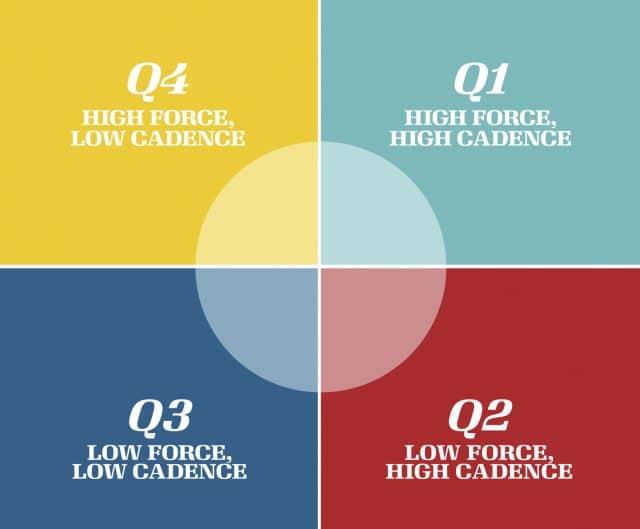What Your Pedalling Style Says About You
Quadrant analysis is a method of analysing race and training data. The report can be generated on computer applications such as WKO+™ and GoldenCheetah™, with data taken from power-meter readings.
Quadrant analysis is a method of analysing race and training data. The report can be generated on computer applications such as WKO+™ and GoldenCheetah™, with data taken from power-meter readings. – Dr Jeroen Swart

The data is based on power production through the varying rates of force and cadence. Because you can produce power with different force-to-cadence ratios (combining high cadence and low force, or low cadence and high force), a quadrant analysis makes it easier to read the data by assigning each of these ratios a set quadrant.
Why is this important?
In competition, the rider needs to produce power in various different scenarios – which vary depending on terrain, tactics, and the speed of the bike, among other factors. These scenarios change the force-to-cadence ratio with which you produce power. This is most evident in XC mountain biking, where speeds are often low and riders require sudden bursts of high power to drive over obstacles. How you produce power is somewhat determined byyour unique characteristics.
A skinny road rider who trains for long durations at steady power will produce power in quadrant 2. In comparison, a larger mountain-bike rider will produce power in quadrant 4.
On the other hand, during training it’s easy to slip into the habit of producing power in a very narrow range within one quadrant, or in the area bordering all four quadrants (the white circle). This often happens if you train regularly on an indoor trainer.
The Benefit
A quadrant analysis is the perfect tool for seeing what your racing habits are, where your strengths and weaknesses lie, and what you need to improve on. You can then train your weaknesses – or if that isn’t possible, strategise your racing around your strengths.
You can also benefit from training specifically to produce power in all four quadrants. This has a measurable benefit on performance, and can give you an extra edge during a race.
—————————————————————————————————————————
QUAD PERFORMANCE BOOSTERS
Try these drills to improve across all four quadrants:
1. 6 x 4 minutes low cadence (40-60RPM), at threshold power. Recover for five minutes at high cadence and low intensity.
2. 3-5 x 10 minutes low cadence (50-60), at 90% threshold power. Rest for 10 minutes.
3. 5-10 x 10-second high-cadence sprints. Let your legs reach their maximum speed, and maintain that cadence for the rest of the sprint.
4. 3-5 x 10 minutes high cadence (80-100), at 90% threshold power. Rest for 10 minutes.
NB! For the low-cadence intervals, find a relatively steep-ish climb (6-10%) to get enough resistance.
For the high-cadence intervals, use a flat stretch of road.

